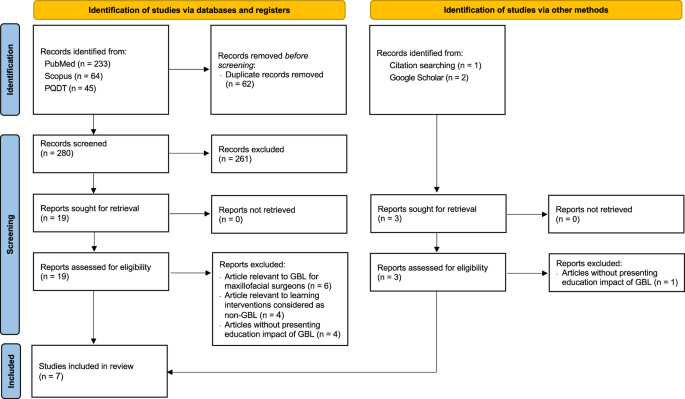Articles identified from the search
The flow of article selection process was presented in the PRISMA diagram (Fig. 1), the search through the four electronic databases revealed 342 articles (PubMed = 233, Scopus = 64, and PQDT Global = 45). Following the removal of 62 duplicate records, 280 articles were screened based on the consideration of their titles and abstracts according to the inclusion and exclusion criteria, in which 261 of them were excluded. Together with three articles identified from the citation searching (n = 1) and Google Scholar (n = 2), 22 full-texts were assessed for their eligibility, where 15 articles were excluded due to being relevant to GBL for maxillofacial surgeons rather than orthodontic practitioners (n = 6), being relevant to learning interventions considered as non-GBL (n = 4), and no education impact of GBL reported (n = 5). Consequently, there were seven full-texts included in this systematic review [18,19,20,21,22,23,24].

PRISMA 2020 flow diagram of the article selection process.
Characteristics of articles included in this systematic review
Four articles evaluated GBL using RCTs to compare its educational impact between GBL and traditional learning approaches [18, 19, 21, 22]. Three studies employed a survey design to explore learner perceptions toward the use of GBL without controlled group [20, 23, 24]. Only one article evaluated the educational impact of GBL in orthodontic postgraduates [21], while the remaining research investigated impact in dental undergraduates [18,19,20, 22,23,24]. Most of the included studies were assessed to have a moderate risk of biases [18, 20,21,22,23,24], whereas one research article exhibited a low risk of bias [19].
Characteristics of GBL evaluated in the included articles
GBL in all included articles emphasized on the educational impact on cognitive domain [18,19,20,21,22,23,24]. Five articles evaluated GBL in digital format designed specifically for orthodontic education were technology enhanced learning [19,20,21,22,23], one research gamified traditional learning approach with the incorporation of audience response system to traditional [18], and one GBL was a card game format [24]. The topics for GBL were varied, covering basic orthodontic concept [18, 22, 24], model analysis [23], cephalometric tracing and analysis [21, 23], prediction in orthognathic surgery [19], and orthodontic bracket bonding [20].
Educational outcomes of the interventions in the included articles
Performance improvement
Three studies evaluated learner performance following the completion of GBL tasks [18, 19, 21], all of which concluded that GBL could offer cognitive improvement in specific aspects of orthodontic education. However, the expected learning outcomes to be achieved across these GBL interventions varied. One study demonstrated better knowledge retention among dental undergraduates with the implementation of an audience response system as an element of GBL [18]. Another study revealed a higher level of cephalometric tracing accuracy among orthodontic residents following the use of shooting game-based activities, although no significant difference of tracing speed was observed [21]. These two studies indicated that GBL can be effective in enhancing learner performance compared to traditional learning methods in orthodontic education. However, one research found no significant difference in knowledge improvement related to the diagnosis and treatment planning of orthognathic cases [19].
User experiences
Six articles investigated user experience toward the use of GBL in orthodontic education contexts, employing questionnaires to assess learner experiences, particularly in terms of enjoyment and engagement, following the learning tasks [18, 20,21,22,23,24]. Among them, three RCTs compared user perceptions between GBL and traditional learning, revealing that participants tended to perceive GBL as more positively in terms of both learning and motivating aspects [18, 21, 22]. However, class involvement of participants was significantly different between GBL and traditional learning [18]. The remaining three articles conducted questionnaire surveys following the GBL activities and found that participants tended to perceive GBL as an effective learning approach, with all studies reporting positive perceptions toward GBL [20, 23, 24]. The findings across the six articles highlighted a notable trend toward favorable perceptions of GBL in orthodontic education at both undergraduate and postgraduate levels.

